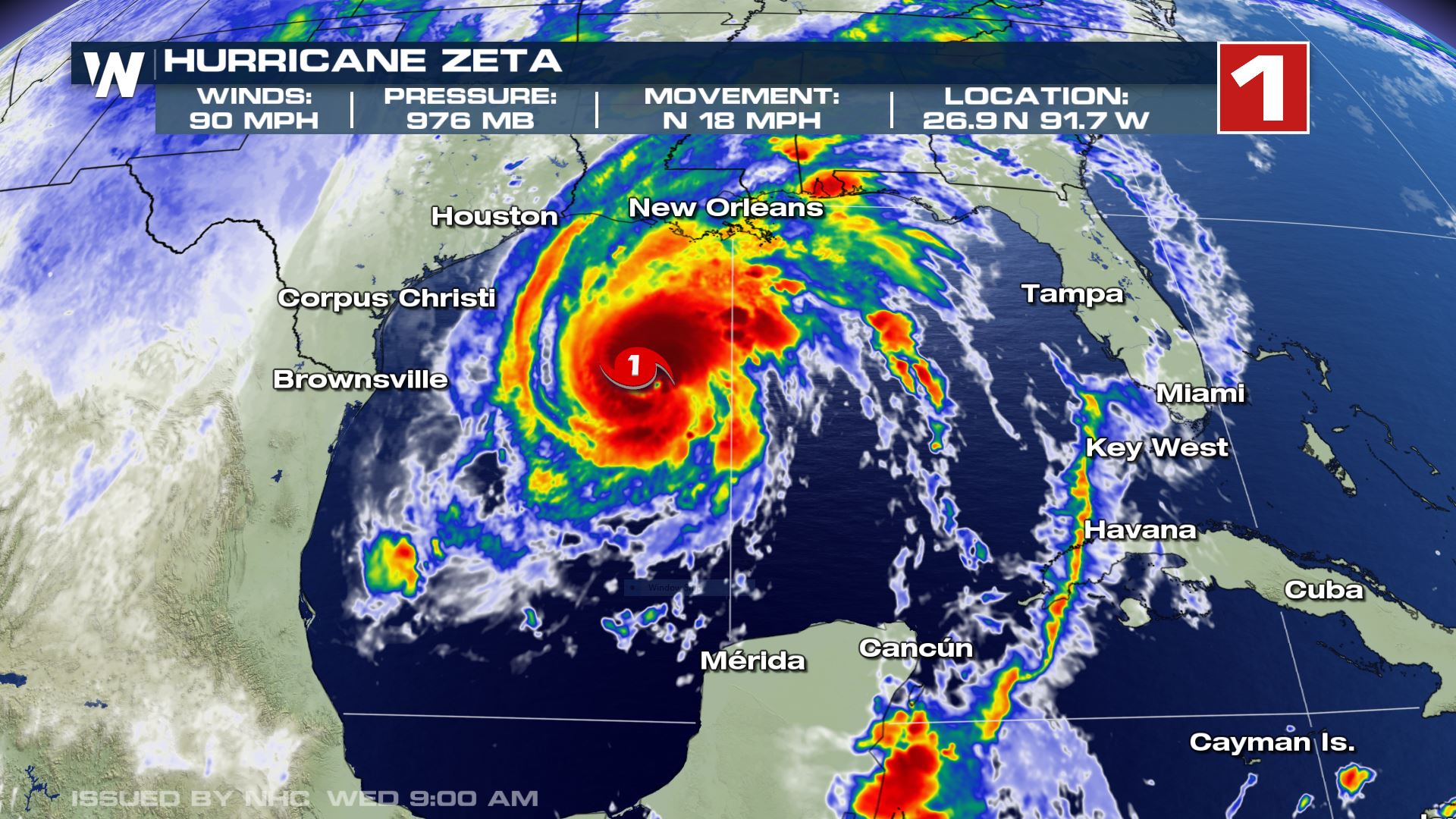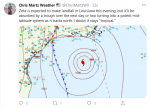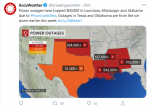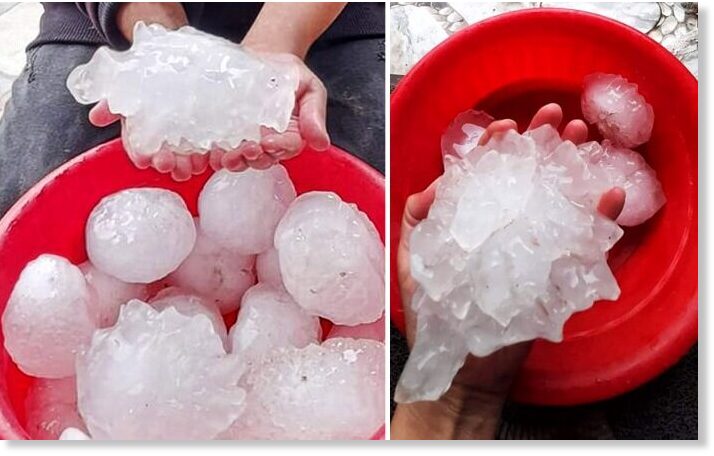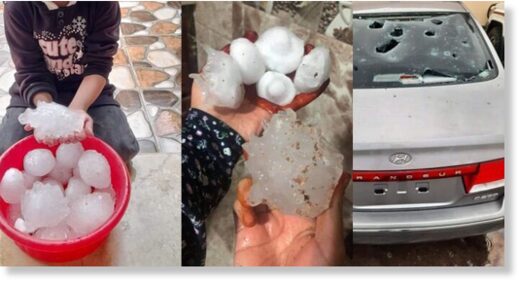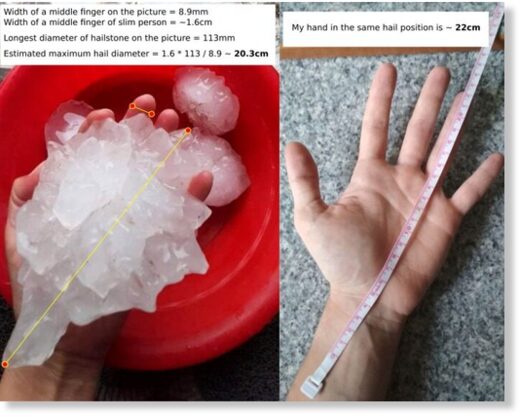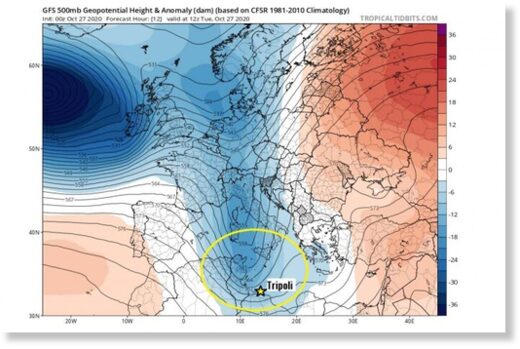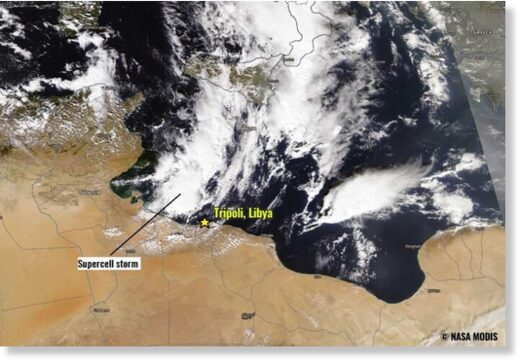A catastrophic ice storm with destructive freezing rain is now underway across northwestern Texas and west-central Oklahoma. While at the same time, Tropical Storm Zeta is emerging back to the Gulf of Mexico after a damaging landfall as a...

www.sott.net
Historic hurricane and ice storm warnings simultaneously in effect across the southern US
Marko Korosec
Sever Weather Europe
Tue, 27 Oct 2020 16:32 UTC
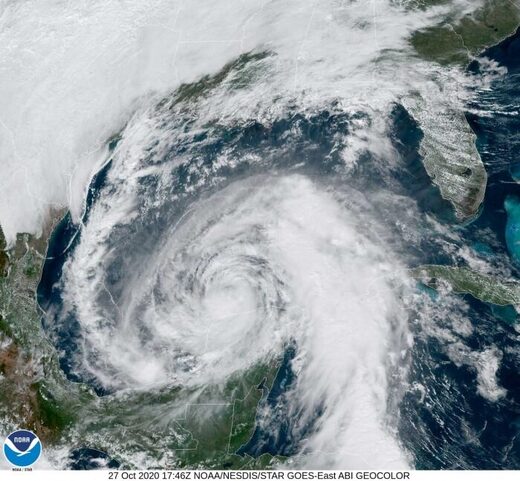
A catastrophic ice storm with destructive freezing rain is now underway across northwestern Texas and west-central Oklahoma. While at the same time, Tropical Storm Zeta is emerging back to the Gulf of Mexico after a damaging landfall as a hurricane in the Yucatan peninsula, Mexico last night. It will re-strengthen into a hurricane and head for the Gulf Coast on Wednesday.
Hurricane Zeta
Hurricane Zeta, the 6th Greek alphabet named storm of Atlantic hurricane season 2020, has made landfall near the city of Consumel, Mexico last night, Oct 26th late evening. The landfall was of a Category 1 strength.
Now, Zeta is soon emerging into the Gulf of Mexico and will re-strengthen into a hurricane and head towards another dangerous landfall at the central Gulf Coast tomorrow.
The same hurricane Delta did two weeks ago. Delta crossed the northern tip of the Yucatan peninsula and made its second landfall in Louisiana a few days later.
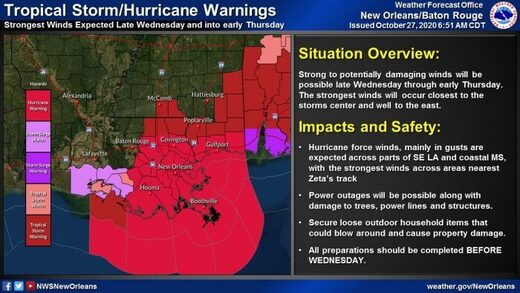
A Hurricane Warning is in effect for the coastal areas of southern Louisiana, Mississippi, and Louisiana.
A Hurricane Warning is in effect for the coastal areas of southern Louisiana, Mississippi, and Louisiana.
Ice Storm in northwest Texas and Oklahoma
As we discussed
last night,
a historic and record-breaking early season Arctic outbreak has penetrated deep south into the southern United States. The core of the Arctic trough has developed a new surface low which is resulting in a catastrophic ice storm across northwest Texas and west-central Oklahoma.
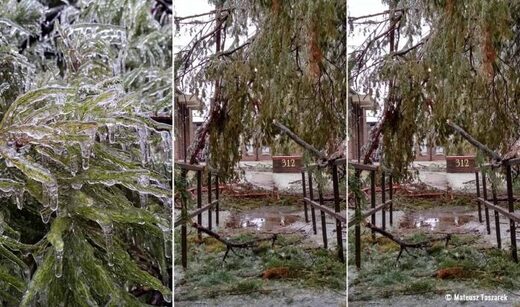
© Photo by: Mateusz Taszarek
Ice storm damage in Norman, Oklahoma.
A massive amount of freezing rain is expected on Tuesday, with widespread tree damage and power outages already reported from parts of Oklahoma and Texas. Heavy rainfall is occurring with subfreezing surface temperature, so ice accumulation is rapidly increasing.
The dangerous winter storm continues, with additional freezing rain and sleet expected through portions of western north Texas and Oklahoma. The Ice Storm Warning continues through Wednesday morning.
And in addition, the Oklahoma City area is under a record-breaking warning - the earliest ice storm warning ever issued.
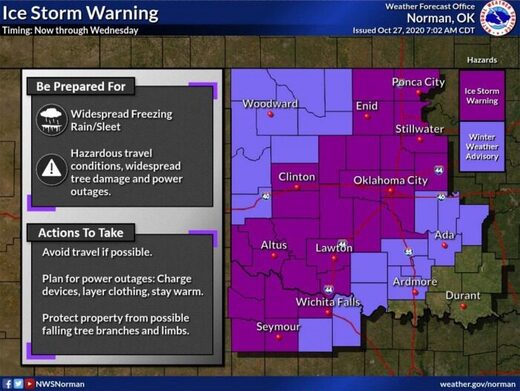
A combination of both, the tropical and winter events, is creating a unique Hurricane Warning versus Ice Storm Warning event across the Southern Plains/Gulf Coast domain.
Both areas under different warning hazards, hurricane warnings, and ice storm warnings are separated by *only* around 400 miles (650 km). This has never happened before.
An ongoing ice storm across Oklahoma and Texas while hurricane Zeta is emerging over the Gulf of Mexico and heading for a landfall in Louisiana tomorrow.
The only other time that a *winter* and a *tropical* warnings could have been in close proximity was with hurricane Sandy in 2012, while the Winter Storm Warning was in effect across western Virginia. But the winter warning was far less prominent than the ongoing event in Texas and Oklahoma.
Hurricane Sandy had its landfall point in New Jersey and it was separated by the swath of intense snowfall in West Virginia. The distance between the events was roughly 350 miles (500 kilometers).
The snowfall event was actually produced by outer bands of Hurricane Sandy.
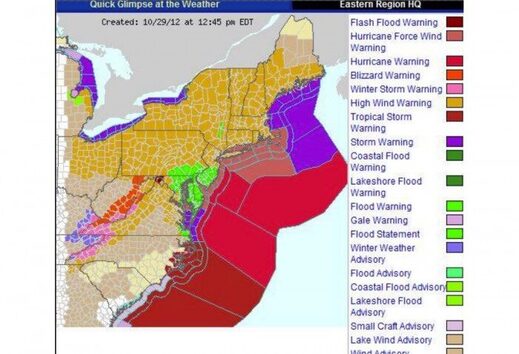
However, Sandy was transitioning to post-tropical storm at that time and as such, the National Hurricane Center (NHC) had discontinued all 'tropical' warnings for the system north of the North Carolina coast. Therefore, although it is the closest idea to the current situation, these events wouldn't fit.
This means the late October Ice Storm Warning across northwestern Texas and west-central Oklahoma versus the hurricane warning in Louisiana are creating a unique and historic event that has never happened before.
It looks like this could be THE year, seriously.
The global Covid-19 pandemic ... a record-breaking Atlantic hurricane season with 10+ United States mainland landfalls ... a historic early season Arctic outbreak with a catastrophic ice storm across the Southern Plains of the United States ... the Arctic sea ice is not freezing In October for the first time since records began ... The worst wildfires across the United States, Siberia ...
What else ... ? Wait, did someone say 2020?!
ICE STORM CONTINUES UNTIL WEDNESDAY MORNING
While additional deep snow is forecast for areas across New Mexico, the Panhandles, and Kansas, the biggest concern is now a very significant impact of freezing rain* with a major ice storm forecast for parts of Texas and Oklahoma until Wednesday.
Ice storms and freezing rain (black ice) are extremely dangerous and damaging during the winter months, but right now it is still only October and most of the trees still have their leaves.
Numerous residential structures could lose electricity for days. To keep in mind that the power lines could break under the weight of the ice alone, even without overhead tree branches crashing down.
*Freezing rain forms when a layer of warm air aloft is placed above a layer of below-freezing (subfreezing) air at the surface. Snowflakes that falling towards the ground, melt as they fall through this warm layer. If the flakes are completely melted, then it is falling as rain towards the ground which is much colder. This liquid droplet then freeze on contact with exposed surfaces
The second round of wintry precipitation has begun across the western portions of Texas and Oklahoma overnight to Tuesday and is now intensifying. The precipitation are also increasing coverage.
There has already been a lot of tree damage and power outages reported, while the greatest amount of snow and ice accumulations in this ice storm event are expected through Tuesday afternoon and evening hours.
Temperatures remain below freezing across the western half of Oklahoma.
Here is the Skew-T (sounding temperature vertical cross-section diagram) for Norman, Oklahoma City (central Oklahoma) at 00 UTC Tuesday. It is revealing an exceptionally deep warm layer placed above the much colder, subfreezing near-surface layers.
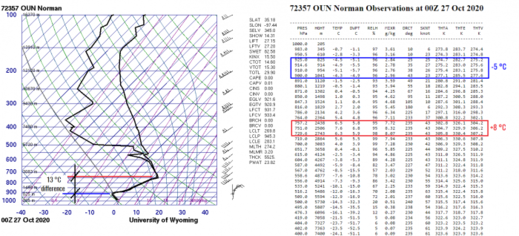
There are temperatures of nearly 13 degrees Celsius (33 degrees F) warmer at 2500 meters above the ground than those at around 1000 meters above the ground. Temperatures are below freezing up to around 1300 meters.
Above freezing temperatures are seen across the layer from 1300 to 3600 meters (approx. 4200 to 11800 feet) above the ground.
Notice there is also strong southwesterly wind aloft, helping to transport high moisture into the region.
The event will continue to produce widespread catastrophic tree damage from northwest Texas into west-southwest and central Oklahoma on Tuesday into early Wednesday. It will also cause power line destruction with numerous power outages as tree branches will be crashing down the powerlines.
The weight of ice accumulating will be significant with this ice storm, especially on trees that still have leaves.
Here is the early Tuesday weather forecast for the total amount of freezing rain by the Pivotalweather model HRRR.
A broad corridor of thick ice accumulation is spread across northwest Texas and west, southwest, and central Oklahoma.
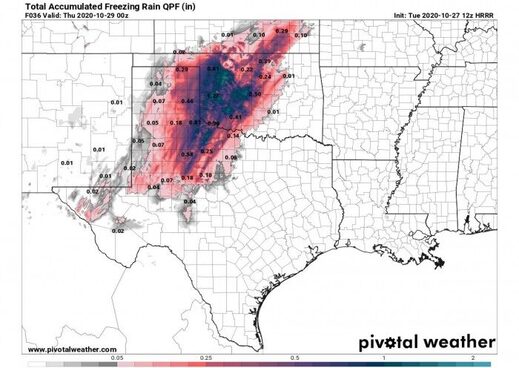 Some areas could see between 1 and 1.5″ (2.5-4 cm) of freezing rain (black ice*) accumulation by Wednesday morning. The event is becoming historic for October this far south in the United States. But it is also extremely destructive.
Some areas could see between 1 and 1.5″ (2.5-4 cm) of freezing rain (black ice*) accumulation by Wednesday morning. The event is becoming historic for October this far south in the United States. But it is also extremely destructive.
The snowy and icy conditions will lead to significant travel hazards across the west north Texas and most of Oklahoma. Be extremely cautious about the rapidly worsening conditions today and through Tuesday night into early Wednesday.
Further west, a swath of impressively high snowfall accumulation remains forecast across northern New Mexico. Additional 10-15 inches (25-40 cm) is forecast by the latest HRRR model.
ZETA ON THE WAY FOR HURRICANE LANDFALL AT THE GULF COAST
*
Latest on Hurricane Zeta: New storms exploding over the Gulf of Mexico, life-threatening landfall is now expected near New Orleans on Wednesday*
According to the National Hurricane Center (NHC), there is a life-threatening storm surge is expected along portions of the northern Gulf Coast by late Wednesday, with the highest inundation occurring somewhere between the Mouth of the Pearl River and Dauphin Island, Alabama. Residents in the Storm Surge Warning area should follow any advice given by local officials.
Zeta is expected to re-intensify over the southern Gulf of Mexico tonight as its structure comes over the still-warm Gulf of Mexico completely. There are still close to 29 °C seawater temperatures across the southern portions of the Gulf, gradually cooler towards the Gulf Coast of the United States.
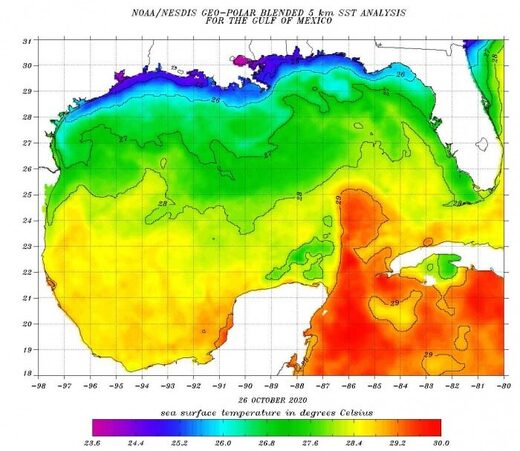
A Hurricane Warning is in effect for the coastal areas of southern Louisiana, Mississippi, and Louisiana.
Hurricane conditions are expected by late Wednesday within portions of the Hurricane Warning area between Morgan City, Louisiana, and the Mississippi/Alabama border. Damaging winds, especially in gusts, will spread well inland across portions of southeast Mississippi and southern Alabama Wednesday night due to Zeta's fast forward speed.
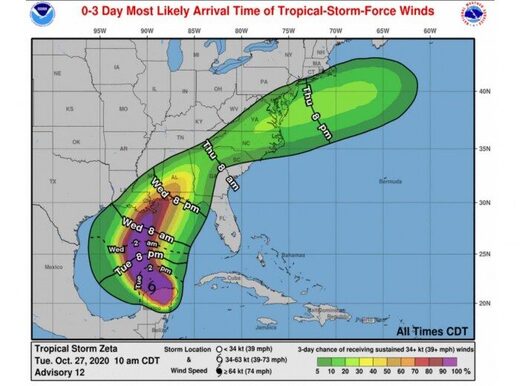
Tropical storm conditions will continue in portions of the northern Yucatan Peninsula of Mexico during the next few hours. Heavy rainfall is expected across the Yucatan Peninsula, the Cayman Islands, and western Cuba today, which will lead to flash flooding in urban areas.
According to Philip Klotzbach, Hurricane Zeta has made landfall in the Mexican state of Quintana Roo as a Category 1 hurricane.
This set a new record as it was the 3rd named storm to make landfall in Quintana Roo this month (Gamma and Delta were the other two). The previous record for October Quintana Roo named storm landfalls was two, set in 1887 and 2005.
Zeta is forecast to be near hurricane strength again prior to making landfall tomorrow (Wednesday) along the northern Gulf Coast. Potentially in southern Louisiana, very near New Orleans.
If Zeta indeed makes landfall as a hurricane, it would be the latest calendar year hurricane to hit the continental United States since Hurricane Kate in 1985.
Hurricane Zeta will bring a lot of rain along its path across the Gulf and across the southeast United States.
Between tonight and Thursday, heavy rainfall is expected from portions of the central U.S. Gulf Coast into the Ohio Valley and the Mid-Atlantic States near and in advance of Zeta. This rainfall will lead to flash, an urban, small stream, and minor river flooding.
After Zeta, the 27th storm of the season, any additional storm names will head into an uncharted area past the existing record of 6 Greek alphabets used in 2005. Tropical Storm Zeta was the last storm name that was designated by the National Hurricane Center in 2005, the only year using the Greek alphabet prior to the 2020 Atlantic hurricane season.
Here is the latest update on a re-developing Zeta tonight:
Hurricane warning for the central Gulf Coast ahead of the re-emerging Zeta, landfall is now expected near New Orleans on Wednesday
*** SEE ALSO ***
The North Atlantic low becomes the most intense extratropical storm of the fall season so far, massive waves spreading towards Ireland and the UK











